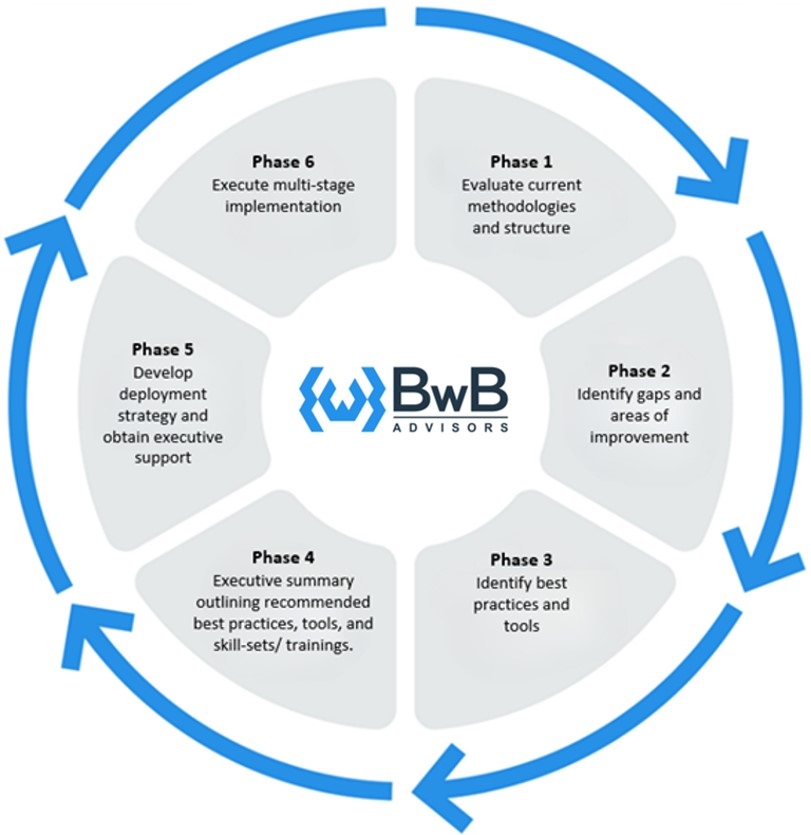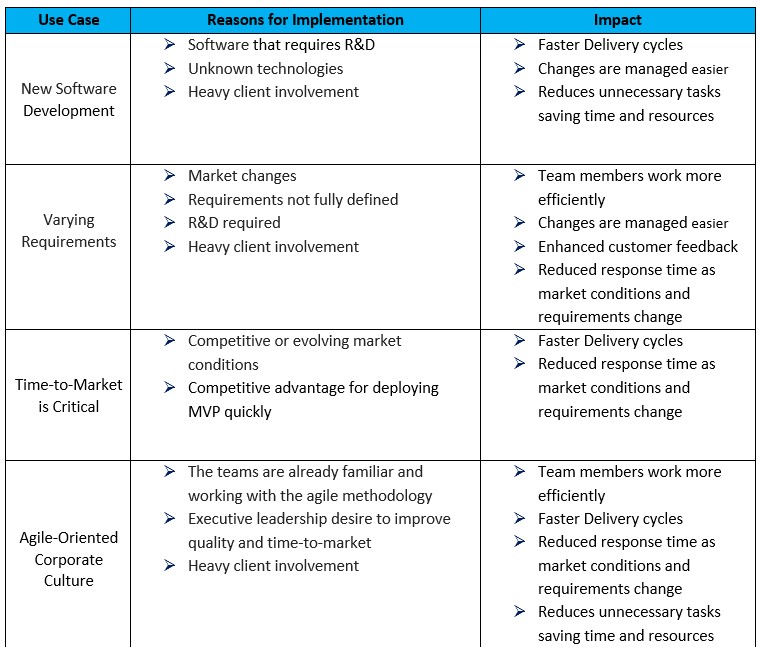Project Management Office - Agile
Agile is an iterative and adaptive methodology that provides faster to market times, enhanced collaboration and increased project quality. In this installment of our Project Management Briefings series, we will focus on the Agile methodology, its key benefits, business impact and use cases.
Overview:
Agile is a comparatively new project management methodology/ framework that was formalized in 2001 and has since been broken out into different types, each of which has evolved to effectively manage specific project types. Agile follows an iterative approach that focuses on continuous releases and incorporating customer feedback into every iteration. Projects are broken up into several dynamic phases, commonly known as sprints. At the end of each sprint stakeholders and the team review their work, make adjustments for the next sprint, and repeat until the project is completed. This makes Agile ideal for projects that require a lot of R&D, have varying requirements, have heavy customer involvement, and need quick-to-market times; especially within the IT industry. Utilizing the Agile methodology provides the framework and best-practices necessary to increase development speed, expand collaboration, and foster the ability to better respond to market trends.
Before we can talk about Agile’s structure and benefits, it is important to first understand how it differs from other methodologies such as Waterfall and plan driven approaches. Adopting Agile is not just a change of methodology but also a change of mindset, and its success is dependent on upholding the key values outlined in the Agile Manifesto.

While older methodologies following a linear model (such as Waterfall) have previously been the dominant project management practice, Agile is becoming increasingly popular as it grows and adapts to suit various project types. According to a 2022 study on the adoption rate of Agile, the IT industry was the highest at 63%, followed by Operations at 29%, Security at 17%, and HR at 16% [1]. Additionally, the failure rate of Agile projects is only about 9%, which is significantly less when compared to the average 29% for Waterfall/ linear projects [3]. While there are still many cases where a traditional/ plan-driven approach to project management is best, Agile’s iterative approach is quickly revolutionizing how many organizations manage and deliver quality projects.
The main difference between the Agile lifecycle and other project lifecycles is the concept of creating and releasing the minimal viable product as quickly and possible, then delivering working code in each subsequent sprint to consistently add value. When using Agile there are certain processes and rituals that are followed. First, the product backlog (a list of requirements broken down into epics, features, and user stories) is aligned with the product vision to identify which features should be added in the upcoming sprint. Next, the team plans for the sprint, identifying what functionality will be added and how long each task should take. A measurement system called story points is used to quickly gauge how long the team thinks a task is going to take; pointing poker and affinity grouping are the two most common methods for quickly estimating work. Then the development/ implementation stage begins, teams self-organize and work through the given tasks for the sprint. Throughout the sprint, there is a daily scrum (also known as a standup call) which is a 15-minute meeting with the enter team, designed to help organize tasks and identify any obstacles. The Sprint Review is used showcase the work that was completed during the sprint. Then a Sprint Retrospective meeting is held, which helps the team identify how they can become more efficient in subsequent sprints. Finally, the work done during the sprint is deployed and the team starts the process over.

While Agile provides a base framework, there are several types/ variations that further tailor the methodology for specific applications. Some of the most common types of Agile include Scrum, Kanban, Lean, and Scaled Agile.
Scrum - the most commonly utilized Agile framework and prioritizes quick and frequent deliveries. Scrum provides a blueprint of values, roles, and guidelines to help teams focus on iteration and continuous improvement. In Scrum, teams are encouraged to learn through experiences, self-organize while working on a problem, and reflect on their wins and losses to continuously improve both the project and their own performance. Scrum teams are small and agile, with each team member playing a significant role in the team’s success, as such, Scrum is best suited for small (6-12 person), cross-functional teams. The main roles in an agile team include the Product Owner, Product Manager, Scrum Master, and team members. The Product Owner and Product Manager are the client roles; the Product Manager follows market trends and identifies what the product should include, which the Product Owner then shapes and relays to the team. The Scrum Master (functioning as a servant-leader) helps take checkpoints and guide the team.
Lean Agile - combines the principles of Lean Manufacturing and Agile Software Development to create a system that is focused on delivering value to customers while minimizing waste. This approach cuts out any task or resource use that doesn't bring value to the project, reducing costs while improving productivity. For example, items such as excessive documentation or formal status reports that don’t add substantial value are reduced or eliminate.
Scaled Agile Framework (SAFe) - a set of organizational and workflow patterns for scaling Agile to the enterprise level. It provides structure for roles and responsibilities, explains how to plan and manage work, and provides values to uphold. SAFe was developed by leveraging three existing frameworks (Scrum, lean product development, and systems thinking) to promote alignment, collaboration, and delivery across large numbers of agile teams. To best accommodate various-sized enterprises, SAFe utilizes four configurations: Essential SAFe, Large Solution SAFe, Portfolio SAFe, and Full SAFe. Regardless of the configuration used, SAFe is optimized for complex projects that involve multiple large teams at the project, program, and portfolio levels. It is important to point out that while other types of Agile such as Scrum or Lean can be scaled, the company would have to build out the processes from scratch, whereas SAFe provides all of the necessary processes and frameworks to scale Agile to any sized enterprise.
Kanban - a visual-based framework that is optimized for teams that work on a continuous improvement and delivery basis. Work items are represented visually on a Kanban board (often as tickets), allowing team members to see the state of every piece of work at any given time. This makes Kanban the ideal method for support and maintenance teams.
Although these are the most common types of Agile used, there are various others, and it is important to choose the correct one for your organization to ensure success with Agile.
Key Benefits:
Agile can produce a variety of benefits that vary depending on the solution as well as the supporting best-practices and tools being implemented. Some of the most common benefits to Agile include:
Faster to-market times: Agile breaks projects down into smaller, more manageable chunks focused on delivering the MVP, the delivering working code after each sprint. This allows the project to quickly adapt to changes in the market.
Increased flexibility: Agile gives teams the ability to easily adjust their approach, requirements, etc. as needed in order to accommodate any changes in project scope or user stories (Agile’s version of requirements), in order to accommodate market changes.
Enhanced customer involvement: By involving customers throughout the development process, teams can get valuable feedback on features and functionality, allowing them to make adjustments as needed to ensure the final product fulfills all of the customer’s needs.
Improved project quality: At the end of each sprint, the team looks for opportunities to become more efficient. These “lessons learned” are then applied to subsequent sprints.
Better team collaboration: The Agile methodology encourages team members to share knowledge and expertise, helping to identify and resolve issues more quickly, and ultimately deliver better results
Use Cases:
While an increasing number of organizations are utilizing the Agile methodology, there are certain industries and use cases where Agile is the most effective. Some of the most common industries that leverage Agile are IT, Marketing, and finance as more flexible and adaptive processes are required in these fields.
See the table below for examples of Agile uses cases and impact within the IT industry:
Implementation Best-Practices:
When implementing Agile there are certain factors that need to be taken into consideration. The corporate culture and company's mindsets (for both leadership and teams) needs to be considered as Agile is radically different from other methodologies, and its success relies on everyone being open to change and new processes.
Another important component is utilizing the correct tools. Similarly to other methodologies, common tools used with Agile include Collaboration, Testing, Code Control, and Planning tools. The two most popular tools for Agile are currently Jira and Azure Dev-Ops, both of which are multi-functional tools used for planning, tracking, testing, and deploying software. Both of these tools also offer the ability to tie in functionality from outside/ third-party services to maximize productivity.
Limitations:
While Agile is a useful methodology, projects can still face issues and there are cases where Agile isn’t the best option. Firstly, Agile’s iterative nature makes it challenging to run projects that require steps to be completed in a certain order such as for manufacturing or construction projects. Secondly, Agile pushes the decision making process down to the correct level so that teams can quickly respond to changes. As this is very different from most methodologies, leadership often has issues with relinquishing control. Thirdly, for an Agile project to be successful it requires that the customer plays an active role in the project; if those resources will not be readily available, leveraging Agile is likely not the best option. Additionally, there are cases where Agile may work, but the project is better suited for other methodologies, we will continue to discuss the benefits and uses cases of other methodologies through the various installments of our Project Management Briefings series.
BwB Advisor’s Methodology for Optimizing Project Management:
As the business world continues to evolve, the approach to project management needs to evolve in parallel. Regardless of your organization’s industry, utilizing the correct best practices and management methodologies can help reduce costs and risk, maximize productivity, and improve the quality of deliverables. Nevertheless, organizations should proceed cautiously in deciding what to adopt — one size does not fit all.
At the BwB Advisors our Project Management Optimization Methodology (PMOM) follows a 6 phase process that provides a comprehensive roadmap from identifying key best practices, tools, and methodologies. This helps to ensure a successful implementation that leads to improved productivity, reduced costs, and increased project success.

To learn more about our PMOM, click here or reach out to us to see how our PMOM can help you by clicking here.
September 2023 / Insights / By: Michael T. Casarona
References:
[1] monday.com, A. of us at. (2023, March 7). A complete guide to the waterfall methodology in 2023. monday.com Blog. https://monday.com/blog/project-management/waterfall-methodology/#:~:text=Yes%2C%20even%20in%202022%2C%20a%20wide%20range%20of,Waterfall%20%E2%80%94%20methods%20in%20the%20past%2012%20months.
[2] When waterfall principles sneak back into agile workflows. Harvard Business Review. (2021, August 27). https://hbr.org/2019/09/when-waterfall-principles-sneak-back-into-agile-workflows.

